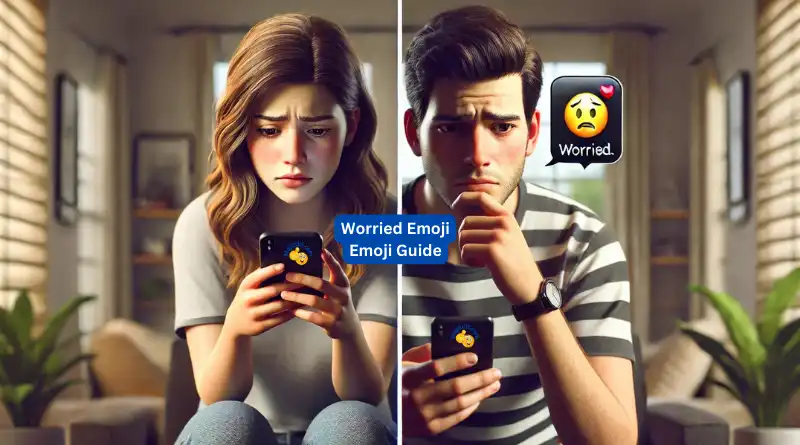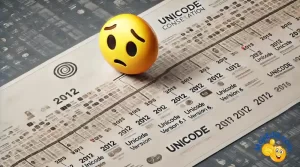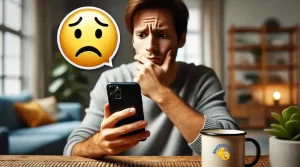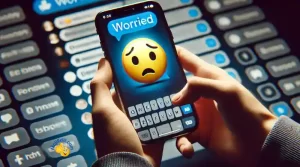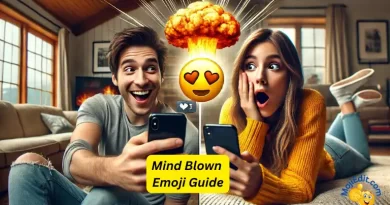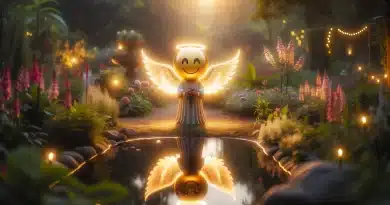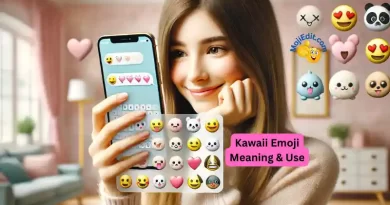O Emoji Preocupado (😟): Tudo o que você precisa saber!
Let’s talk about the worried emoji (😟). This little guy might look simple, but it packs a punch when it comes to expressing emotions. Whether you’re feeling anxious about a test, worried about a friend, or just having one of those days, the worried emoji is your go-to.
It’s subtle yet powerful, and it can convey so much more than words alone. We are about to dive deep into the world of the worried emoji. We’ll explore its anatomy, history, usage, cultural interpretations, and even some fun combos you can try out. So, buckle up and get ready to become an emoji expert! 🚀
Principais conclusões
- Poder de expressão: The worried emoji (😟) is perfect for showing anxiety, concern, or worry in digital conversations.
- Design visual: It features a downturned mouth, furrowed eyebrows, and large eyes to convey a worried expression.
- Histórico: Added in 2012 as part of Unicode 6.1, this emoji has become a staple in conveying worry.
- Interpretações culturais: Its meaning can vary across different cultures, from showing politeness to indicating mild concern.
- Dicas de uso: Combine-o com outros emojis para obter expressões com mais nuances e entenda seu contexto para usá-lo com eficiência.
The Anatomy of the Worried Emoji
What is the Worried Emoji? 😟
The worried emoji, officially known as the “worried face emoji,” is designed to convey a sense of anxiety, concern, or unease. It’s like the emoji version of biting your nails or furrowing your brows when you’re stressed out about something. 😰
Detalhamento visual
Let’s break down the visual elements that make this emoji so expressive:
- Downturned Mouth: The slight frown on this emoji’s face is key to showing worry. It’s not a full-blown sad face, but just enough to show concern.
- Furrowed Eyebrows: Those tiny lines above the eyes add to the worried look. They make the emoji seem like it’s deep in thought or stressing over something.
- Large, Open Eyes: The wide, open eyes are a big part of what makes this emoji look so anxious. It’s like they’re saying, “Oh no, what’s going to happen next?”
Each of these elements works together to create an expression that we can all relate to when we’re feeling worried or anxious. 😟
Diferentes designs de plataforma
Did you know that the worried emoji can look a bit different depending on which platform you’re using? Here’s a quick look at some variations:
- Apple: On Apple devices, the worried emoji has a very clear frown and raised eyebrows, making it look genuinely concerned.
- Google: Google’s version has a similar expression, but the eyes are a bit larger, adding to the anxious vibe.
- Samsung: Samsung’s worried emoji has a slightly different mouth shape but still conveys the same worried emotion.
No matter which device you’re on, you’ll recognize that this emoji is all about showing worry. But these slight variations can add a little twist to how the emotion is perceived.
History of the Worried Emoji
As origens
The worried emoji (😟), like many emojis, was developed to help convey emotions in digital communication where words might fall short. Emojis have become an essential part of how we text, tweet, and post, adding an extra layer of expression to our words.
Consórcio Unicode
The Unicode Consortium is the organization responsible for standardizing characters, including emojis, across different platforms and devices. They ensure that when you send an emoji from your iPhone, it looks the same when viewed on a friend’s Android phone. Pretty neat, right? 😄
Version and Year Added
The worried emoji was introduced in Unicode version 6.1, which was released in January 2012. This version added a significant number of new emojis, reflecting the growing importance of these tiny images in our digital communication.
Adição ao teclado de emojis
The worried emoji was officially added to the emoji keyboard in 2012, as part of the Emoji 1.0 release. This release marked a major milestone in the standardization of emojis, ensuring consistency across different platforms and devices. It meant that no matter what device you were using, you could express your worry with this little guy. 😟
Ponto de código Unicode
Every emoji has a unique identifier known as a Unicode code point. The worried emoji is represented by the Unicode code point U+1F61F. This hexadecimal code places it within the “Emoticons” block, which contains a wide range of other emoji characters.
Resumo da linha do tempo
To make it easier to remember, here’s a quick timeline of the worried emoji’s history:
| Evento | Detalhes |
|---|---|
| Consórcio Unicode | Supervisiona o padrão Unicode e os emojis |
| Versão adicionada | Unicode 6.1 |
| Ano adicionado | 2012 |
| Adicionado ao teclado de emojis | Lançamento do Emoji 1.0 |
| Ponto de código Unicode | U+1F61F |
This emoji has since become an essential tool for conveying concern, anxiety, and worry in our digital conversations. Its standardized appearance across platforms helps ensure that its meaning remains consistent, making it a reliable choice for expressing subtle emotions. 😟
Uso e popularidade
Contexto emocional
The worried emoji (😟) is super versatile. It’s perfect for expressing a wide range of anxious or concerned feelings. Whether you’re stressed about an exam, worried about a friend, or feeling uneasy about a situation, this emoji has got your back. 💪
Here are some common scenarios where you might use the worried emoji:
- Expressing Anxiety: “I have a big presentation tomorrow 😟”
- Showing Concern: “I heard you’re not feeling well. Are you okay? 😟”
- Feeling Uneasy: “This situation is making me uncomfortable 😟”
Estatísticas de uso diário
Emojis are a huge part of our daily digital lives. Did you know that over 5 billion emojis are sent daily on Facebook Messenger alone? 😲 And the worried emoji is one of the key players when it comes to expressing concern or anxiety.
According to Twitter statistics, the worried emoji appears in a significant number of tweets every day. People use it to convey their feelings in a quick and easily understandable way. After all, a picture is worth a thousand words, right? 😉
Comparação com emojis semelhantes
While the worried emoji (😟) is popular, it’s not alone in expressing concern. Let’s look at how it stacks up against some similar emojis:
- Rosto ansioso com suor: Esse emoji é usado para ansiedade mais intensa, geralmente quando algo o está deixando realmente estressado.
- 😢 Crying Face: Often used when worry turns into sadness or distress.
- Rosto gritando de medo: Used for moments of extreme shock or terror, when worry becomes overwhelming fear.
Even though these emojis might convey similar emotions, the worried emoji is perfect for those moments when you’re concerned but not overwhelmed. It’s the sweet spot between mild anxiety and full-blown panic. 😅
A Tool for Subtlety
In an age where over one in five tweets include an emoji (21.54% to be exact!), the worried emoji stands out as a symbol of subtlety. While emojis like 😂 (Face With Tears of Joy) dominate Twitter as the most used emoji, the worried emoji offers a more nuanced way to express less intense but still significant emotions.
Fatos divertidos
- Facebook Messenger: Did you know that over 900 million emojis are sent without any accompanying text? That’s a lot of worried faces out there! 😟
- Emoji Evolution: The worried emoji has evolved over the years, adapting to different platforms while keeping its core expression of concern intact.
Worried Emoji in Action!
Conversas por texto
The worried emoji (😟) is a versatile tool in text conversations. It helps you convey emotions that might be hard to put into words. Here are some examples of how you can use it in your chats:
Example 1: Mild Irritation Amigo: “Sorry, I can’t make it tonight. Something came up.” Você: “😟 That’s the third time this week.”
In this example, the worried emoji shows mild irritation without coming across as too harsh. It subtly expresses your feelings.
Example 2: Expressing Apathy Coworker: “We have another meeting at 3 PM today.” Você: “😟 Another one? Didn’t we just have one this morning?”
Here, the worried emoji highlights your lack of enthusiasm or interest in the additional meeting.
Example 3: Deadpan Humor Amigo: “I just ate the spiciest pepper in the world. I think I might die.” Você: “😟 You always say that.”
Adding the worried emoji here adds a layer of deadpan humor, emphasizing the exaggerated nature of your friend’s statement.
Example 4: Neutral Reaction Classmate: “I think the new teacher is really strict.” Você: “😟 I haven’t noticed anything different.”
In this context, the worried emoji conveys a neutral or indifferent opinion about the new teacher.
Example 5: Subtle Disappointment Sibling: “I borrowed your favorite book and accidentally spilled coffee on it.” Você: “😟 Great. Just what I needed.”
This response shows subtle disappointment without escalating the situation, maintaining a calm tone.
Using the worried emoji in these ways can help you navigate various social interactions with nuance and clarity. It’s a valuable addition to your digital communication toolkit. 💬✨
Combinando Emojis para uma melhor expressão
Creating nuanced messages with the worried emoji can enhance your digital conversations. By pairing it with other emojis, you can convey more complex emotions and scenarios. Here are some examples of effective combinações de emojis:
1. Mild Confusion Emoji Combo: 😟😕 Uso: “I’m not sure what you mean. 😟😕”
This combination uses the worried emoji and the confused face emoji to express mild confusion or uncertainty without appearing too distressed.
2. Subtle Irritation Emoji Combo: 😟😒 Uso: “You forgot to bring the notes again? 😟😒”
Pairing the worried emoji with the unamused face emoji underscores a sense of irritation, showing your slight annoyance.
3. Neutral to Thoughtful Pensamento Emoji Combo: 😟🤔 Uso: “That’s an interesting point. 😟🤔”
This sequence transitions from worry to thoughtful consideration, showing that you are processing the information.
4. Deadpan Humor Emoji Combo: 😟😂 Uso: “Yeah, that joke was hilarious. 😟😂”
Combining the worried emoji with the laughing face emoji can add a layer of irony or sarcasm, making your humor more nuanced.
5. Mild Disapproval Emoji Combo: 😟🙄 Uso: “Really, another meeting? 😟🙄”
Using the worried emoji with the eye roll emoji conveys mild disapproval or exasperation without being overly harsh.
6. Indifference to Boredom Emoji Combo: 😟😴 Uso: “This lecture is going on forever. 😟😴”
This combination transitions from worry to boredom, effectively expressing your lack of interest or engagement.
7. Subtle Shock Emoji Combo: 😟😮 Uso: “You did what? 😟😮”
Pairing the worried emoji with the surprised face emoji can show that you’re taken aback in a subtle way, indicating mild shock.
These emoji combinations allow you to convey a wider range of emotions and reactions, making your messages more expressive and engaging. By creatively using the worried emoji with others, you can enhance the depth and clarity of your digital conversations. 🌟📱
Nuances emocionais e contextuais
The worried emoji (😟) is perfect for conveying subtle emotions. It’s not just about showing worry; it can express a variety of feelings depending on the context. Let’s dive into the different ways you can use this versatile emoji. 💬
Conveying Mild Irritation and Apathy
Sometimes, you need to show irritation or apathy without coming across as too harsh. The worried emoji can help with that:
- Exemplo: Your friend is late for the third time this week.
- Mensagem: “You’re late again 😟”
- Exemplo: You’re told there’s another mandatory meeting.
- Mensagem: “Another meeting? 😟 Didn’t we just have one?”
In these cases, the worried emoji keeps things light, showing your mild irritation without escalating the situation.
Expressing Confusion and Indifference
The neutral expression of the worried emoji can also convey confusion or indifference:
- Exemplo: You don’t understand a classmate’s question.
- Mensagem: “I’m not sure what you’re asking 😟”
- Exemplo: You hear some uninteresting news.
- Mensagem: “Oh, really? 😟”
These uses show how the worried emoji can reflect a “meh” attitude, expressing a lack of enthusiasm or confusion without being too negative.
Tendências culturais e demográficas
The worried emoji (😟) is used by people of all ages, but it’s particularly popular among younger demographics. Let’s take a closer look at how different groups use this emoji.
Diferenças de idade e gênero
Statistics show that 86% of emoji users on Twitter are 24 or younger, and 57% of those users are women. The worried emoji is especially popular among these groups, who often use it to convey a variety of nuanced emotions, from mild irritation to subtle humor. 📊
Mídia social e mensagens
Emojis play a huge role in enhancing communication on social media and messaging platforms. More than 700 million emojis are used in Facebook posts every day, and the worried emoji is frequently employed to add context to posts, comments, and messages that require a balanced emotional tone. 🌐
The Emotional Impact of the Worried Emoji
Aprimorando as conversas digitais
The worried emoji helps prevent misinterpretations and maintains a composed and calm interaction, especially in potentially sensitive conversations. It’s a great way to express concern or anxiety without sounding too harsh. 😟
Preenchendo lacunas emocionais
In text-based communication, where tone and intent can be easily misinterpreted, the worried emoji serves as a valuable tool for bridging emotional gaps. It allows users to convey their feelings more accurately, ensuring that the intended sentiment is understood. 💬❤️
Summary Table
| Aspecto | Detalhes |
|---|---|
| Conveying Mild Irritation | Shows slight annoyance without being harsh (e.g., “You’re late again 😟”) |
| Expressing Confusion | Indicates confusion or indifference (e.g., “I’m not sure what you’re asking 😟”) |
| Diferenças de idade e gênero | Popular among users 24 or younger, especially women |
| Social Media Use | Frequently used in Facebook posts and Twitter comments to add context |
| Impacto emocional | Helps prevent misinterpretations and maintain a calm tone in conversations |
| Preenchendo lacunas emocionais | Aids in conveying feelings more accurately in text-based communication |
The worried emoji is a powerful tool for nuanced digital communication. Understanding its various uses and cultural interpretations can help you express your emotions more effectively. 😊🌍
Worried Emoji in Different Cultures

Culturas ocidentais
In Western cultures, the worried emoji often conveys indifference, mild irritation, or a neutral stance. It’s commonly used to show a lack of enthusiasm or to downplay a situation. For example, someone might use it in a text like, “Stuck in traffic again 😟,” to indicate frustration without being overly dramatic.
Culturas orientais
In some Eastern cultures, the worried emoji can be interpreted as a sign of politeness or modesty. Rather than showing strong emotions, it might be used to maintain harmony and avoid conflict. For instance, in a conversation about a sensitive topic, someone might use the worried emoji to keep the tone neutral and respectful.
Culturas latino-americanas
In Latin American cultures, the worried emoji can sometimes be seen as humorous or sarcastic. It might be used to respond to a joke or a playful comment, adding a layer of deadpan humor. For example, if a friend makes an exaggerated statement, replying with “Really? 😟” can add a humorous touch.
Culturas do Oriente Médio
In Middle Eastern cultures, the worried emoji might be used in a similar way to Western cultures, conveying a sense of neutrality or mild frustration. However, it’s also sometimes used in professional settings to maintain a formal tone. For example, in a work-related chat, someone might use it to express a neutral reaction to a colleague’s suggestion.
Tabela de resumo cultural
| Cultura | Interpretação | Exemplo de uso |
|---|---|---|
| Culturas ocidentais | Indifference, mild irritation, neutral stance | “Stuck in traffic again 😟” |
| Culturas orientais | Politeness, modesty, maintaining harmony | “Let’s discuss this later 😟” |
| Culturas latino-americanas | Humor, sarcasm, deadpan response | “Really? 😟” |
| Culturas do Oriente Médio | Neutrality, mild frustration, formal tone | “I’ll consider it 😟” |
Understanding these cultural interpretations can help you use the worried emoji more effectively in your conversations, making sure your intended meaning is clear and appropriate. 🌍😊
Related Worried Emojis
The worried emoji (😟) is part of a broader family of emojis that convey similar expressions of neutrality, indifference, or mild irritation. Understanding these related emojis can enhance your digital communication by providing a range of nuanced reactions. Here are some commonly used related emojis:
😰 Anxious Face with Sweat Emoji
The anxious face with sweat emoji (😰) features a worried expression with a bead of sweat, indicating nervousness or stress. It’s often used when someone is feeling overwhelmed or under pressure.
- Use Case: "Tenho uma grande apresentação amanhã 😰"
😟 Worried Face Emoji
The worried face emoji (😟) is similar to the neutral face but with a slightly more concerned expression. It’s perfect for showing mild worry or anxiety without being overly dramatic.
- Use Case: “I hope everything goes well 😟”
😨 Fearful Face Emoji
The fearful face emoji (😨) shows a wide-eyed expression with a frown, indicating fear or shock. It’s used when someone is scared or startled by something.
- Use Case: “Did you see that horror movie? 😨”
😢 Crying Face Emoji
The crying face emoji (😢) depicts a face with a tear rolling down its cheek. It’s often used to show sadness, disappointment, or emotional distress.
- Use Case: “I’m really going to miss you 😢”
😱 Face Screaming in Fear Emoji
The face screaming in fear emoji (😱) features a wide-open mouth and hands on the cheeks, reminiscent of the famous painting “The Scream” by Edvard Munch. It’s used for moments of extreme shock or terror.
- Use Case: “That jump scare got me so bad! 😱”
😐😕 Combination
Combining the straight face emoji (😐) with the confused face emoji (😕) can amplify the sense of mild confusion or uncertainty.
- Use Case: “I’m not sure what you mean. 😐😕”
😐😒 Combination
Pairing the straight face emoji with the unamused face emoji (😒) underscores a stronger sense of irritation or boredom.
- Use Case: “You forgot to bring the notes again? 😐😒”
🤔 Thinking Face Emoji
The thinking face emoji (🤔) shows a face with a hand on its chin, furrowed eyebrows, and a contemplative expression. It’s used to indicate deep thought or consideration.
- Use Case: “That’s an interesting point. 😟🤔”
Summary Table
| Emoji | Descrição | Caso de uso |
|---|---|---|
| Rosto ansioso com suor | Worried expression with a bead of sweat | "Tenho uma grande apresentação amanhã 😰" |
| 😟 Worried Face | Slightly concerned expression | “I hope everything goes well 😟” |
| 😨 Fearful Face | Wide-eyed expression with a frown | “Did you see that horror movie? 😨” |
| 😢 Crying Face | Face with a tear, indicating sadness | “I’m really going to miss you 😢” |
| Rosto gritando de medo | Wide-open mouth and hands on cheeks, showing terror | “That jump scare got me so bad! 😱” |
| 😐😕 Combination | Straight face Emoji + confused face | “I’m not sure what you mean. 😐😕” |
| 😐😒 Combination | Straight face + unamused face | “You forgot to bring the notes again? 😐😒” |
| 🤔 Thinking Face | Hand on chin, furrowed brows, contemplative look | “That’s an interesting point. 😟🤔” |
Esses emojis relacionados podem ajudá-lo a transmitir uma gama mais ampla de emoções e reações, tornando sua comunicação digital mais expressiva e diferenciada. 🌟📱
Copy and Paste the Worried Emoji
Want to express your concern or anxiety quickly and easily in your messages or posts? You can effortlessly copy the worried emoji (😟) and paste it wherever you need to show some worry or unease. Follow these simple steps:
- Clique no botão "Copiar" abaixo to copy the worried emoji to your clipboard.
Emoji Copied! 😟 - Ir para o local onde você deseja usar o emoji e clique com o botão direito do mouse no campo de texto.
- Choose “Paste” from the context menu, or simply use the keyboard shortcut Ctrl + V (Windows) or Cmd + V (Mac) to paste the emoji.
An
d voilà! You’re all set to add some subtle concern to your conversations. 😟
Conclusão
The worried emoji (😟) has become an indispensable part of our digital communication, offering a subtle yet effective way to convey worry, concern, or anxiety. Introduced in 2012 as part of Unicode 6.1, this emoji quickly gained popularity and was standardized across various platforms to ensure consistent use and understanding.
Understanding the nuances of the worried emoji in different cultures can significantly enhance your communication skills, allowing you to express the right emotions in the right contexts. Whether you’re using it to maintain politeness in Eastern cultures, add humor in Latin America, or express mild frustration in Western settings, this emoji is a versatile tool.
By exploring related emojis, such as the anxious face with sweat (😰), crying face (😢), and fearful face (😨), you can add more depth and nuance to your digital conversations. The ability to combine the worried emoji with others, like the thinking face (🤔) or confused face (😕), further expands its expressive potential.
For those interested in using this emoji more efficiently, we provided a simple guide to copy and paste the worried emoji (😟) into your messages. Additionally, the historical context and technical details, such as its Unicode code point (U+1F61F), offer a deeper appreciation of this digital symbol.
In summary, the worried emoji is more than just an expression of concern; it’s a powerful tool for nuanced communication. Whether you’re a casual texter or a professional communicator, understanding and utilizing this emoji can enhance your ability to convey emotions effectively in the digital world. 😊💬
Perguntas e respostas frequentes
The worried emoji (😟) conveys anxiety, concern, or worry. It’s used to show that you’re feeling uneasy or stressed about something.
Use the worried emoji when you want to express mild anxiety or concern. It’s perfect for situations where you’re worried about a friend, an upcoming test, or any scenario that makes you feel uneasy.
Common combinations include 😟😕 for mild confusion, 😟😒 for subtle irritation, 😟🤔 for thoughtful consideration, and 😟😮 for subtle shock.
The worried emoji (😟) is different from similar emojis like the anxious face with sweat (😰) or the crying face (😢) because it shows a more general sense of worry without the added elements of tears or sweat.
Western cultures often use it to show indifference or mild irritation, Eastern cultures may interpret it as a sign of politeness or modesty, Latin American cultures might see it as humorous or sarcastic, and Middle Eastern cultures might use it to maintain a formal tone in professional settings.

